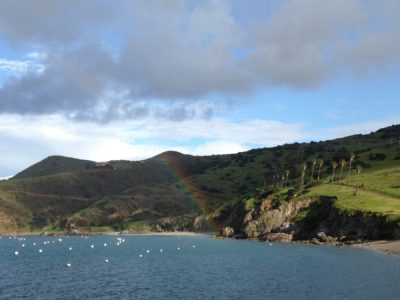
UPDATE 1/22/2015: For more information on our Oarfish check out this story from the BBC News: http://www.bbc.com/earth/story/20150115-mystery-of-the-real-life-sea-serpent
On October 13th, 2013 a staff member at Catalina Island Marine Institute was snorkeling when a large eye floated into her vision. Upon further investigation our staff discovered this amazing 18 foot long Oarfish. The 2015 Guinness Book of World Records named the Oarfish as the longest bony fish to be recorded. Due to the rarity of this long Oarfish we invited staff from the National Oceanic Atmospheric Administration (NOAA) to join us in studying this incredible creature.
The three visitors arrived on November 7th to study the Oarfish’s otolith, vertebrate and full body X-ray. The names and findings from the visitors is as follows:
Mrs. Bev Macewicz
Southwest Fisheries Science Center NOAA
8901 LaJolla, CA 92037
858-546-7107
bev.macewicz@noaa.gov
Mr. Terry Snow
Konica Minolta Medical Imaging USA
National Sales Support Manager
Commercial Marketing Team
973-557-1790
terry.snow@konicaminolta.us
Steve Midway PhD
PA Fish and Wildlife Cooperative Research Unit
406 Forest Resources
University Park, PA 16802
814-865-6646
svm30@psu.edu
Immediate Findings:
The head section of the oarfish (~36 inches) was the first section X-rayed from multiple angles to find the otolith cavity. The cavity was found in between the two orbital cavities. Upon dissection, the head was full of gelatinous flesh and cartilage. Little bone was found within the head. The otoliths were found beneath the brain cavity. We believe one otolith was recovered from the Oarfish. There are normally two otoliths but the Oarfish otoliths are only a few millimeters big. So, the fact that we might have found one otolith is amazing. NOAA was unable to find the otolith of the Oarfish that washed up in Oceanside. Once Steve gets back to his lab, he will confirm whether or not we actually retrieved an otolith. We took a picture of what we found in plankton lab.
There were four vertebrate taken from the back end of the head section. The vertebrate were hard bone on one end and soft/cartilaginous on the other. The vertebrate were filled with gelatinous sacks. X-rays were taken of the four vertebrate. To better understand their shape and function After the dissection, X-rays were taken of all seven Oarfish sections ranging from 24’’ to 36’’. The beginning of the vertebrate column began within the head section posterior of the two orbital cavities. The X-rays were taken using a Konica Minolta portable X-ray machine. This was an impressive piece of machinery. Terry hopes to hatch all of the sections together to form a full scale X-ray of the Oarfish. We should hear back from everybody in the near future about any more findings.
Thank you Guinness World Record for including us in your record books!



